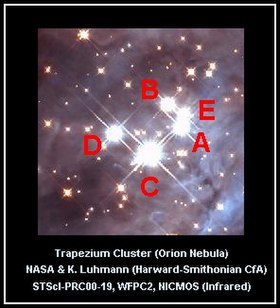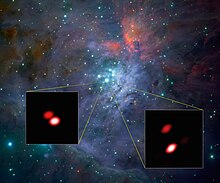 Theta Orionis C and companions in the Trapezium cluster | |
| Observation data Epoch J2000 Equinox J2000 | |
|---|---|
| Constellation | Orion |
| Right ascension | 05 35 16.46375 |
| Declination | −05° 23′ 22.8486″ |
| Apparent magnitude (V) | 5.13 |
| Characteristics | |
| Spectral type | θ Orionis C1: O6Vp θ Orionis C2: B0V |
| U−B color index | −0.95 |
| B−V color index | +0.02 |
| Variable type | suspected |
| Astrometry | |
| Radial velocity (Rv) | +23.6 ± 2.0 km/s |
| Proper motion (μ) | RA: −4.13 mas/yr Dec.: 6.82 mas/yr |
| Parallax (π) | 2.11 ± 0.41 mas |
| Distance | 410 ± 20 pc |
| Absolute magnitude (MV) | −4.9 |
| Details | |
| C1 | |
| Mass | 33 ± 5 M☉ |
| Radius | 10.6 ± 1.5 R☉ |
| Luminosity | 204,000 L☉ |
| Surface gravity (log g) | 4.1 cgs |
| Temperature | 39,000 ± 1,000 K |
| Rotational velocity (v sin i) | 24 ± 3 km/s |
| Age | 2.5 ± 0.5 Myr |
| C2 | |
| Mass | 11 ± 5 M☉ |
| Orbit | |
| Primary | C1 |
| Companion | C2 |
| Period (P) | 11.05 ± 0.03 yr |
| Semi-major axis (a) | 40.00 ± 3.00″ |
| Eccentricity (e) | 0.534 ± 0.050 |
| Inclination (i) | 100.7 ± 1.0° |
| Longitude of the node (Ω) | 25.3 ± 1.5° |
| Argument of periastron (ω) (secondary) | 290.9 ± 2.5° |
| Other designations | |
| 41 Ori C, HR 1895, HD 37022, SAO 132314, HIP 26221, BD–05° 1315C | |
| Database references | |
| SIMBAD | data |

Theta Orionis C (θ Orionis C) is a member of the Trapezium open cluster that lies within the Orion Nebula. The star C is the most massive of the four bright stars at the heart of the cluster. It is an O class blue main sequence star with a B-type main sequence companion. Its high luminosity and large distance (about 1,500 light years) give it an apparent visible magnitude of 5.1.
Theta Orionis consists of multiple components, primarily the four stars of the Trapezium cluster, all within one arc-minute of each other. Theta Orionis is a more distant grouping of three main stars plus several fainter companions, 1-2 arc-minutes from Theta.
Theta C is itself a binary of two massive stars, C1 and C2, plus a very close fainter companion apparently escaping the system.
Theta Orionis C1 is responsible for generating most of the ultraviolet light that is slowly ionizing (and perhaps photoevaporating) the Orion Nebula. This UV light is also the primary cause of the glow that illuminates the Orion Nebula. The star emits a powerful stellar wind that is a hundred thousand times stronger than the Sun's, and the outpouring gas moves at 1,000 km/s.
References
- ^ van Leeuwen, F. (November 2007), "Validation of the new Hipparcos reduction", Astronomy and Astrophysics, 474 (2): 653–664, arXiv:0708.1752, Bibcode:2007A&A...474..653V, doi:10.1051/0004-6361:20078357, S2CID 18759600
- ^ Ducati, J. R. (2002). "VizieR Online Data Catalog: Catalogue of Stellar Photometry in Johnson's 11-color system". CDS/ADC Collection of Electronic Catalogues. 2237: 0. Bibcode:2002yCat.2237....0D.
- "Science Source Stock Video - Trapezium C1 main sequence star, animation".
- ^ Balega, Yu. Yu.; Chentsov, E. L.; Leushin, V. V.; Rzaev, A. Kh.; Weigelt, G. (2014). "Young massive binary θ 1 OriC: Radial velocities of components". Astrophysical Bulletin. 69 (1): 46–57. Bibcode:2014AstBu..69...46B. doi:10.1134/S1990341314010052. ISSN 1990-3413. S2CID 120838635.
- Samus, N. N.; Durlevich, O. V.; et al. (2009). "VizieR Online Data Catalog: General Catalogue of Variable Stars (Samus+ 2007–2013)". VizieR On-line Data Catalog: B/GCVS. Originally Published in: 2009yCat....102025S. 1: 02025. Bibcode:2009yCat....102025S.
- Olivares, J.; Sánchez, L. J.; Ruelas-Mayorga, A.; Allen, C.; Costero, R.; Poveda, A. (2013). "Kinematics of the Orion Trapezium Based on Diffracto-Astrometry and Historical Data". The Astronomical Journal. 146 (5): 106. arXiv:1310.0769. Bibcode:2013AJ....146..106O. doi:10.1088/0004-6256/146/5/106. ISSN 0004-6256. S2CID 119110490.
- ^ Kraus, S.; Weigelt, G.; Balega, Y. Y.; Docobo, J. A.; Hofmann, K.-H.; Preibisch, T.; Schertl, D.; Tamazian, V. S.; Driebe, T.; Ohnaka, K.; Petrov, R.; Schöller, M.; Smith, M. (2009). "Tracing the young massive high-eccentricity binary system θ1Orionis C through periastron passage". Astronomy and Astrophysics. 497 (1): 195–207. arXiv:0902.0365. Bibcode:2009A&A...497..195K. doi:10.1051/0004-6361/200810368. ISSN 0004-6361. S2CID 14555075.
- ^ Simón-Díaz, S.; Herrero, A.; Esteban, C.; Najarro, F. (2006). "Detailed spectroscopic analysis of the Trapezium cluster stars inside the Orion nebula". Astronomy and Astrophysics. 448 (1): 351–366. arXiv:astro-ph/0510288. Bibcode:2006A&A...448..351S. doi:10.1051/0004-6361:20053066. ISSN 0004-6361. S2CID 16445304.
- Vitrichenko, E. A.; Lehmann, H.; Klochkova, V.; Bychkova, L.; Bychkov, V. (2010). "Detection of a star escaping from the Orion Trapezium". Astrophysics. 53 (2): 306–308. Bibcode:2010Ap.....53..306V. doi:10.1007/s10511-010-9120-2. ISSN 0571-7256. S2CID 123527966.
| Constellation of Orion | |||||||||||||
|---|---|---|---|---|---|---|---|---|---|---|---|---|---|
| Stars |
| ||||||||||||
| |||||||||||||
| Star clusters |
| ||||||||||||
| Nebulae |
| ||||||||||||
| Galaxies |
| ||||||||||||
| |||||||||||||